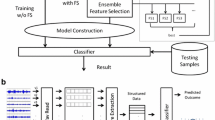Abstract
Biosignals are considered as important sources of data for diagnosing and detecting abnormalities, and modeling dynamics in the body. These signals are usually analyzed using features taken from time and frequency domain. In theory‚ these dynamics can also be analyzed utilizing Poincaré plane that intersects system’s trajectory. However‚ selecting an appropriate Poincaré plane is a crucial part of extracting best Poincaré samples. There is no unique way to choose a Poincaré plane‚ because it is highly dependent to the system dynamics. In this study, a new algorithm is introduced that automatically selects an optimum Poincaré plane able to transfer maximum information from EEG time series to a set of Poincaré samples. In this algorithm‚ EEG time series are first embedded; then a parametric Poincaré plane is designed and finally the parameters of the plane are optimized using genetic algorithm. The presented algorithm is tested on EEG signals and the optimum Poincaré plane is obtained with more than 99% data information transferred. Results are compared with some typical method of creating Poinare samples and showed that the transferred information using with this method is higher. The generated samples can be used for feature extraction and further analysis.










Similar content being viewed by others
References
Strumillo P, Ruta J (2002) Poincaré Mapping for Detecting Abnormal Dynamics of Cardiac Repolarization. IEEE Eng Med Biol Mag Jan/Feb:62–65
Williams G (1997) Chaos theory. Joseph Henry Press‚ Washington
Hilborn R (2001) Chaos and Nonlinear Dynamics‚ An introduction for scientists and engineers‚ 2nd edn. Oxford University Press‚ Oxford
Yalcınkaya T, Lai Y (1997) Phase characterization of chaos. Phys Rev Lett 79(20):3885
Tucker W (2002) Computing accurate Poincaré maps. Physica 171:127–137
Letellier C, Gilmore R (2009) Poincaré sections for a new three-dimensional toroidal attractor. Physics A 42:015101
Garfinkel‚ A, Spano‚ M, Ditto W, Weiss J (1992) Controlling cardiac chaos. Science New Series 257:1230–1235
Yang S (2004) Nonlinear signal classification using geometric statistical features in state space. Electron Lett 40(12):780–781
Magauer A, Banerjee S (2000) Bifurcations and chaos in the tolerance B and PWM technique. IEEE Trans Circ Syst 47(2):254–259
Perez Velazquez‚ J, Khosravani‚ H, Lozano A, Berj B‚ CarleN P, Wennberg R (1999) Type III intermittency in human partial epilepsy. Eur J Neurosci 11(7):2571–2576
Jalali‚ S, Lasseter R, Dobson I (1994) Dynamic response of a thyristor controlled switched capacitor. IEEE Trans Power Deliv 9(3):1609–1615
Kabiri‚ K, Henschel S, Martí J, Dommel H (2005) A discrete state-space model for ssr stabilizing controller design for TCSC compensated systems. IEEE Trans Power Deliv 20(1):466–474
Timmer J, Haussler S, Lauk M, Lucking C (2000) Pathological tremors: deterministic chaos or nonlinear stochastic oscillators. Chaos 10(1):278–288
Bodruzzaman‚ M, Devgan S, Kari S (1992) Chaotic classification of electromyographic (emg) signals via correlation dimension measurement. In: IEEE Southeastcon‚ Birmingham
Janson‚ N, Balanov‚ A, Anishchenko VS, McClintock P (2001) Phase synchronization between several interacting processes from univariate data. Phys Rev Lett 86(9):1749
Morimoto J, Nakanishi J, Endo G, Cheng‚ G, Atkeson C, Zeglin G (2005) Poincaré-map-base reinforcement learning for biped walking. In: 2005 IEEE international conference on robotics and automation (ICRA)
Tsankov T, Nishtala A, Gilmore R (2004) Embeddings of a strange attractor into R^3. Phys Rev E Stat Nonlin Soft Matter Phys 69:056215
Shen T, Kuo X, Hsin Y (2009) A novel seizure prediction method based on probability density distribution of poincaré chaos. In: IEEE TENCON‚ pp 4244–4547
EEG Database‚ Seizure Prediction Project, University of Freiburg
Acknowledgements
We sincerely thank Freiburg University in Germany for providing seizure prediction EEG database. This research has been supported by Tehran University of Medical Sciences & Health Services‚ Grant No. 20174 and Research Center for Biomedical Technologies and Robotics (RCBTR).
Author information
Authors and Affiliations
Corresponding author
Ethics declarations
Conflict of interest
The authors declare that they have no conflict of interest.
Ethical approval
This study does not contain any study with human participants or animals performed by any of authors.
Rights and permissions
About this article
Cite this article
Sharif, B., Jafari, A.H. Design of an optimum Poincaré plane for extracting meaningful samples from EEG signals. Australas Phys Eng Sci Med 41, 13–20 (2018). https://doi.org/10.1007/s13246-017-0599-2
Received:
Accepted:
Published:
Issue Date:
DOI: https://doi.org/10.1007/s13246-017-0599-2




